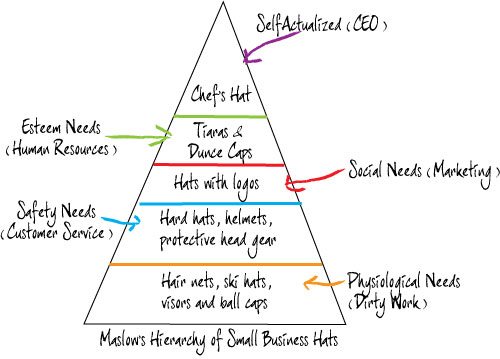You’re just like me.
A small business owner who doesn’t have their own marketing department (or who can’t afford to hire an expert).
Who wears all the hats and later wonders why you have a “bad case of hat head” (as one of my clients likes to say).
And whose arms are not quite long enough to get all the way around the proverbial load you’ve got to carry.
Yep. It’s a struggle. But it comes with the entrepreneurial territory.
And usually, it’s the result (we believe) of having way too many kick-ass ideas, and not enough time to execute.
I’ll confess. I feel that way most of the time, too. But logically, I know it’s really all about focus. Oh, yeah. And having a process to play that focus out.
We’re All Different
Disclaimer: What works for me, may or may not work for you. So think about what your strengths and weaknesses are and how you like to work:
- Are you a morning person? Or a night owl? When does your brain work best?
- Do you prefer to write with a pen? Or on the computer? Or would you rather talk your ideas out? How do you get the best flow?
- Are you a confident writer? Or are you still learning? What skills do you need to develop?
7 Tips for Writing When You Don’t Have Enough Time
Get organized and create a plan. The only way you’ll ever be able to push your creativity into the “production” zone, is with a plan. That means you’ve got to do things like:
- Block out time on your calendar (set an actual appointment with yourself) to write. Set aside at least 30 minutes (I like to have 1.5 hours) at whatever time of day you’re at your best (creatively speaking). Make that time sacred. It’s yours. It’s for your business. And it needs to happen. But don’t go longer than 90 minutes at a stretch. Especially if you’re not a marathon writer. The brain can only focus for so long before it overloads. And you’ll know you’re at overload when you start craving chocolate or feel the need to check your email.
- Find more time. We all have the same 24 hours. If your business is important to you, you’ll sometimes need to give something else up. Or, hire someone and delegate some of the things you’re currently holding onto. I’ve found that most solopreneurs or micro business owners actually do have the time. They just don’t realize it. For tips on how to look deeper at your particular situation, talk to a productivity coach like my colleague, Annie Sisk of Pajama Productivity.
- Create a ritual (process) to help you focus. Jonathan Fields talks about this in his new book, Uncertainty (I’m currently reading, so stay tuned for a review). I like to get my coffee, do a couple of yoga stretches and then plop down on the couch. Away from my work desk. I even use a different laptop that just has the bare bones apps (so I’m not tempted to work on any side projects).
- Prime the pump. Begin with some warm ups for your fingers by writing at least three good-sized paragraphs about anything. Anything that doesn’t matter. I usually do a brain dump about all the stuff I’m worried about. This helps me clear out the creative passages between my mind and my hands. And when I do start to write the important stuff, it seems to come a lot easier. (Actually, this is part of the ritual above.)
- Use an editorial calendar and plan ahead. Magazine publishers do it. And so do the best bloggers. Guess what? You’re a publisher, too. Here’s a template you can use as a starting point. You could also use a whiteboard, or any other writing surface to keep track of your writing schedule. My editorial calendar is always about one month ahead of the current date. And it takes into account all my guest posts, interviews and other extraneous tidbits I know I need to work on.
- Organize your ideas. If you’re old school and need the reassuring feel of pen and paper, then get yourself a binder and add a few file pockets and some notepaper. Post-its can work, too. But I usually reserve those for a specific project as they can get WAY out of hand. And If you’re a geek like me, you might opt to use Evernote as a way to keep track of all those fabulous ideas, research and interesting stories you stumble across. I have to use a combination of both methods — a small notebook lives in my purse for those times when I’m out and about and inspiration strikes. But most of the time, I keep everything in virtual “stacks” in my Evernote account. It’s great because I can access it from any computer.
- Speak your words. Use a digital recorder (they’re handy ‘cuz you can carry them around) or better yet, invest in some voice recognition software. I use Dragon Naturally Speaking. It takes just a little bit of time to set up, but works really well — especially for folks who can’t seem to get their brains and fingers to work in sync. Plus, we humans can talk way faster than we can type. If you find yourself struggling to write, but you know you can talk, this might be just the ticket.
5 Tips for Writing When You Don’t Have Enough Ideas
If you’re trying to write copy for your website or other marketing materials, but don’t know where to start, sign up for my free 5-part web marketing course. It’s a great way to get the bones down of what you need to say in order to make a sale. Plus, we talk about how to put some all-important flesh on those bones, once you’re done with the basics. If you’re stuck for a blog or article topic, there are plenty of places to look. The challenge is finding the really great ones. Here are five of my favorites:
- Use a mindmap. They’re great tools for capturing ideas, and if you’ve never used one before, here’s a great video explanation. For this exercise, start with a bubble in the middle of the paper that you label with your secret sauce (whatever it is you do or sell that your customers want to pay money for). From there, start small and think about the topics related to better understanding your thing. For example, if you sell used designer handbags, one topic might be ‘How to tell a real from a fake.’ Another might be about latest trends. Then draw another node and list experts you could interview. Or maybe you could ask your customers to share their best tips for how to care for a bag. Just keep going until you can’t think of anything else. When you’re done, post it up on your wall. As you come up with new ideas, you can draw them in. And if you’d rather do this online, I recommend spicynodes.com.
- Curate other information. Pick a topic that your readers would find helpful. If you were a catering company and your niche was weddings, you could list the Top 21 places for a wedding in your area. If you were a life coach, you could gather tips from other self-improvement professionals and create a list of tips in one particular area (like time management or weight loss). The beauty of these types of pieces is that your content may go much further as the other professionals or vendors share your list, too.
- Read more. Make it a habit to read at least one book or magazine in your industry each month. Supplement your reading with at least 3 to 5 good newsletters in your niche. Start with the top sites in your industry. Look first at your professional association (there’s one for everything — even tortilla makers). Subscribing to these helps you stay on top of new developments and trends that you can then pass on to your customers. Take notes as you find things you could expand on with just a bit more research.
- Write more. There’s no getting around it. Writing primes the pump. What you need to do is give yourself permission to suck…and then keep writing anyway. Or, if you’re really brave, join a writers’ group totally unrelated to the writing you normally do. If you write for business, choose a poetry group. Or if you write nonfiction, find a group that works on short stories. Eventually you’ll get to the good stuff. Promise. [blackbirdpie url=”http://twitter.com/#!/kellykingman/status/126310724715806720″]
- Do some of your own research. Conduct a survey or facilitate a focus group discussion around a topic important to your industry or niche. Then write about your findings. If you gather enough data to be statistically relevant, your report could be important enough to gain the attention of the media-at-the-large (which would help push your content even further). Plus, your participants would be perfect prospective customers.
- Solicit ideas from your current customers. Start by looking at comments you’ve already received — either on a blog post, or via social media. What questions are you hearing? If you’re not hearing anything, make an official effort by asking. Use the Facebook questions tool or send a Tweet (DM or @ reply) to followers individually. You could even write a post about asking for ideas like I did here.
There are a ton of great blog posts out there that also talk about blog posts and article ideas. This is one I just curated.
What about you? Have you used any of these tips yourself? Have something else that totally rocks? Share your experience in a comment. I’d love to hear from you.











There’s enough information here to make the head spin. I downloaded SpiceyNodes at your suggestion to do mind-mapping but not yet opened it. I have nice big white walls just waiting for the pen!Evernote is less challenging and after watching all their training videos am up to intermediate standard there. It looks like a great way to collect stuff and it has a voice memo facility which allows voice memos to be attached to notes.”Block out the time on the calendar”: if only clients would stop dropping in unexpectedly. Doing a brain dump – Yes! A mind cleared of worries sounds like the way to writing brilliance. Thanks for a heap of great ideas – don’t know how you managed to do this with everything else going on.
Tea, your Maslow’s hierachy of small business hats is sublime. How many of us could claim to be wearing the Chef’s hat, do you think? Moving from the doing to the managing is probably a good step upward. Audio is a great way to capture ideas. I don’t know whether the iphone is as ubiquitous elsewhere as here in Oz, but if you have one just use the voice memo feature. The beauty of it is that you can share your recording directly to your email to use as the base of your post. Or you can upload it to your blog directly as a post.
Great post! I just started using mindmaps and not only are they effective, but super fun!
Wow, what a fantastic post! I especially like No. 7 ‘Speak your Words’. When I’m writing I often try to write ‘speeches’, or what I could use as a speech if needed. I’ve done this ever since writing my papers at university, and it seems to work well for me. my girlfriend often yells at me for reading my posts out loud, as it’s my main way of ensuring my grammar is as good as I can get it! Great post! 🙂
What a great topic: how to write more when you don’t have ideas. Most bloggers have lots of ideas but can’t get to them. That’s why my favorite is to use a mind map. I’ve been fascinating with them but not able to figure them out. The figure was a big help.
Two of your suggestions are favorites of mine, too: Writing up research after doing a survey and speaking your words. I recently used the survey approach to get a handle on a topic I was asked to write about. In fact, it worked so well that time I got 3 strong articles out of it!Another cool tip for speaking — if software like Dragon Naturally Speaking isn’t in the budget just yet, use free software like Audacity to capture your words. Good stuff!
i like the idea of a mindmap, Tea…i’ve heard of the concept many times, but haven’t used it IRL yet. Methinks it would be an illuminating exercise!
Primping the pump is a great way to get an article, blog or whatever started. So is using a mindmap to spark new ideas and creative connections. And here’s one I did not know — an association for tortilla makers. Thanks for the wisdom and humor, Tea.
While I don’t struggle with ideas (my mind is always firing in at least 5 directions), the actually getting it written can be a real headache. I love all the ideas for finding the time. One thing I have discovered that works for me – taking my laptop to a coffee shop, turning off the phone and internet and then just writing. Very productive.
Nice one, Tea! I especially like the ideas for being productive when you don’t feel inspired as I think that’s an area that’s often left out. Curation is a great one though it helps to remember to look at the stuff you’ve collected. 😉
Great post, Tea! I’m impressed you got this done while you were moving and dealing with the Carnival – excellent example of ruthless productivity in action!